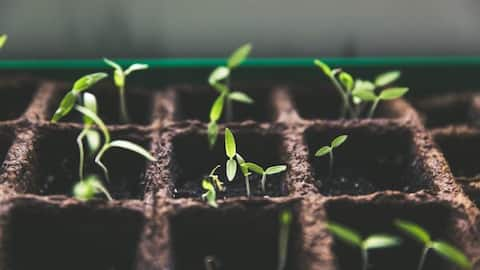Companion planting: Growing plants that help each other
What's the story
Companion planting, a traditional gardening method, strategically situates various plant species together to promote growth, repel pests, and boost yield. This technique leverages natural plant interactions to foster a harmonious ecosystem. By pairing "companion" plants, they can support each other's development, attracting beneficial insects, repelling harmful ones, or acting as distractions to safeguard more susceptible plants. Let us understand the benefits of this practice.
Pest control
Symbiosis
Companion planting relies on the concept of symbiosis among plants, where each species contributes to the well-being of the others. Some plants produce natural substances that repel pests or attract beneficial insects, which can help protect neighboring plants from damage. For example, planting aromatic herbs like basil and mint near susceptible crops such as tomatoes can deter pests like aphids and whiteflies.
Nutrient cycling
Enhancing soil nitrogen
Certain plants have deep or shallow root systems that access different layers of soil, allowing them to absorb nutrients more efficiently. Legumes like peas and beans harbor nitrogen-fixing bacteria in their roots, enriching the soil with this vital nutrient. This enrichment benefits neighboring crops that rely on nitrogen for growth, like corn, which thrives well beside leguminious plants.
Complementary growth
Maximize efforts
Pairing plants with complementary growth habits can optimize space utilization and light exposure in the garden. For instance, tall plants like corn can provide support for climbing vegetables like beans or cucumbers, while ground cover plants like thyme or clover can suppress weeds and retain soil moisture around larger crops. It is a perfect practice for space gardens and maximizes efforts.
Trap cropping
Sacrificial hosts
Certain plants possess the ability to act as sacrificial hosts to pests, drawing them away from valuable crops and thus protecting them from damage. For instance, by planting marigolds alongside vegetables, gardeners can effectively divert pests such as nematodes or aphids towards these sacrificial plants. This strategy not only helps safeguard more vulnerable crops but also reduces the need for chemical pest control methods.
Shade regulation
Prevents sunburn
When small leafy plants are planted in the partial shade of taller plants, they can effectively manage direct sunlight and prevent smaller plants from scorching under extreme sun. This shading not only helps regulate temperature and moisture levels but also reduces the risk of sunburn and premature flowering (bolting) in delicate leafy greens and herbs thereby prolonging their harvest.
Examples
Carrots with onions or tomatoes
Planting carrots alongside onions benefits both crops: onions repel carrot flies and deter aphids, while carrots, sensitive to heat, thrive when planted near tomato plants that offer shade. Moreover, tomatoes naturally produce solanine, acting as a natural insecticide against pests that affect carrots. Additionally, carrots aid in soil aeration around tomato roots, enhancing air and water circulation, further benefiting both crops.
Other companions
Many more
Basil serves as a beneficial companion to peppers, warding off pests such as aphids, spider mites, mosquitoes, and flies. Additionally, the proximity of basil is believed to enhance the flavor of peppers, making them even more delicious and appealing. Similarly, radishes when planted alongside onions, beets, cabbage, kale, lettuce and spinach form beneficial relationships that support their growth and overall garden health.
